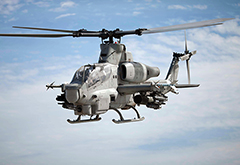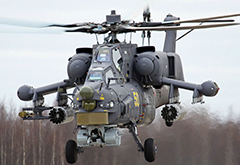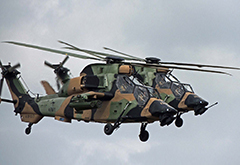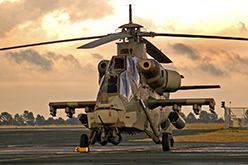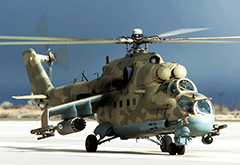1- Boeing AH-64 Apache Helicopter:
The Boeing AH-64 Apache is a four-blade, twin-turboshaft attack helicopter with a tailwheel-type landing gear arrangement, and a tandem cockpit for a two-man crew. It features a nose-mounted sensor suite for target acquisition and night vision systems. It is armed with a 30 mm (1.18 in) M230 chain gun carried between the main landing gear, under the aircraft's forward fuselage. It has four hardpoints mounted on stub-wing pylons, typically carrying a mixture of AGM-114 Hellfire missiles and Hydra 70 rocket pods. The Apache originally started as the Model 77 developed by Hughes Helicopters for the United States Army's Advanced Attack Helicopter program to replace the AH-1 Cobra. More details
2. Kamov KA-50/KA-52 Helicopter:
The Kamov Ka-50 "Black Shark" is a single-seat Russian attack helicopter with the distinctive coaxial rotor system of the Kamov design bureau. It was designed in the 1980s and adopted for service in the Russian army in 1995. It is being used as a heavily armed scout helicopter. Kamov also designed two-seat variant, the Kamov Ka-52 "Alligator". In comparison to the original Ka-50, it has a "softer" nose profile and a radar system with two antennas—mast-mounted for aerial targets and nose-mounted for ground targets. "Samshit" day-and-night TV/thermal sighting system in two spherical turrets are also present. The Ka-52 retains the side-mounted cannon of the original Ka-50. More details
The Kamov Ka-50 "Black Shark" is a single-seat Russian attack helicopter with the distinctive coaxial rotor system of the Kamov design bureau. It was designed in the 1980s and adopted for service in the Russian army in 1995. It is being used as a heavily armed scout helicopter. Kamov also designed two-seat variant, the Kamov Ka-52 "Alligator". In comparison to the original Ka-50, it has a "softer" nose profile and a radar system with two antennas—mast-mounted for aerial targets and nose-mounted for ground targets. "Samshit" day-and-night TV/thermal sighting system in two spherical turrets are also present. The Ka-52 retains the side-mounted cannon of the original Ka-50. More details
3. Bell AH-1Z Viper Helicopter:
The Bell AH-1Z Viper is a twin-engine attack helicopter based on the AH-1W SuperCobra, that was developed for the United States Marine Corps. The AH-1Z features a four-blade, bearingless, composite main rotor system, uprated transmission, and a new target sighting system. The AH-1Z is part of the H-1 upgrade program. It is also called "Zulu Cobra" in reference to its variant letter. More details
4. Mil Mi-28 Helicopter:
The Mil Mi-28 (NATO reporting name "Havoc") is a Russian all-weather, day-night, military tandem, two-seat anti-armor attack helicopter. It is a dedicated attack helicopter with no intended secondary transport capability, better optimized than the Mil Mi-24 gunship for the role. It carries a single gun in an undernose barbette, plus external loads carried on pylons beneath stub wings. More details
5. Eurocopter Tiger Helicopter:
The Eurocopter Tiger is a four-bladed, twin-engined attack helicopter which first entered service in 2003. It is manufactured by Eurocopter, the successor company to Aérospatiale's and Daimler-Benz Aerospace AG's respective helicopter divisions, which designate it as the EC 665. In Germany it is known as the Tiger; in France and Spain it is called the Tigre. Development of the Tiger started during the Cold War, and it was initially intended as an anti tank helicopter platform to be used against a Soviet ground invasion of Western Europe. During its prolonged development period the Soviet Union collapsed, but France and Germany chose to proceed with the Tiger, developing it instead as a multirole attack helicopter. More details
The Eurocopter Tiger is a four-bladed, twin-engined attack helicopter which first entered service in 2003. It is manufactured by Eurocopter, the successor company to Aérospatiale's and Daimler-Benz Aerospace AG's respective helicopter divisions, which designate it as the EC 665. In Germany it is known as the Tiger; in France and Spain it is called the Tigre. Development of the Tiger started during the Cold War, and it was initially intended as an anti tank helicopter platform to be used against a Soviet ground invasion of Western Europe. During its prolonged development period the Soviet Union collapsed, but France and Germany chose to proceed with the Tiger, developing it instead as a multirole attack helicopter. More details
6. Agusta A129/T129 Helicopter:
The Agusta A129 Mangusta is an attack helicopter originally designed and produced by Agusta. It has the distinction of being the first attack helicopter to be designed and produced wholly in Europe. It has continued to be developed by AgustaWestland, the successor company to Agusta. The A129 has undergone several combat deployments since entering service with the Italian Army in the 1990s. A derivative of the A129, the TAI/AgustaWestland T129 ATAK, is being developed by Turkish Aerospace Industries (TAI), who shall produce the T129 for the Turkish Army and potentially other export customers, AgustaWestland is serving as the primary partner on the T129. More details
The Agusta A129 Mangusta is an attack helicopter originally designed and produced by Agusta. It has the distinction of being the first attack helicopter to be designed and produced wholly in Europe. It has continued to be developed by AgustaWestland, the successor company to Agusta. The A129 has undergone several combat deployments since entering service with the Italian Army in the 1990s. A derivative of the A129, the TAI/AgustaWestland T129 ATAK, is being developed by Turkish Aerospace Industries (TAI), who shall produce the T129 for the Turkish Army and potentially other export customers, AgustaWestland is serving as the primary partner on the T129. More details
7. Denel AH-2 Rooivalk:
The Denel Rooivalk (previously designated AH-2 and CSH-2) is an attack helicopter manufactured by Denel of South Africa. Rooivalk is Afrikaans for "Red Kestrel". The South African Air Force (SAAF) ordered 12 Rooivalks, designated the Rooivalk Mk 1 in SAAF service, the first of was officially handed over in April 2011. The helicopters are flown by 16 Squadron, which is based at AFB Bloemspruit near Bloemfontein. More details
8. Bell AH-1 SuperCobra:
The Bell AH-1 SuperCobra is a twin-engine attack helicopter based on the United States Army's AH-1 Cobra. The twin Cobra family includes the AH-1J SeaCobra, the AH-1T Improved SeaCobra, and the AH-1W SuperCobra. The AH-1W is the backbone of the United States Marine Corps's attack helicopter fleet, but it will be replaced in service by the Bell AH-1Z Viper upgrade. More details
9. Mil Mi-24 Hind Helicopter:
The Mil Mi-24 Hind is a large helicopter gunship and attack helicopter[1] and low-capacity troop transport with room for eight passengers. It is produced by Mil Moscow Helicopter Plant and has been operated since 1972 by the Soviet Air Force and its successors, along with more than 30 other nations. In NATO circles, the export versions, Mi-25 and Mi-35, are denoted with a letter suffix as "Hind D" and "Hind E" respectively. Soviet pilots called the Mi-24 the "flying tank". More common unofficial nicknames were "Crocodile" due to the helicopter's camouflage scheme and "Drinking Glass" because of the flat glass plates which surround the cockpit of the Mi-24. More details
10. CAIC Z-10 Helicopter:
The Z-10 also called WZ-10, is an attack helicopter developed by the People's Republic of China. It is designed primarily for anti-tank warfare missions but has secondary air-to-air capability as well. It was designed by Kamov design bureau of Russia under a contract by the Chinese government. It was further developed and flight tested by the 602nd Research Institute under Wu Ximing and is being built by Changhe Aircraft Industries Corporation (CAIC). More details


